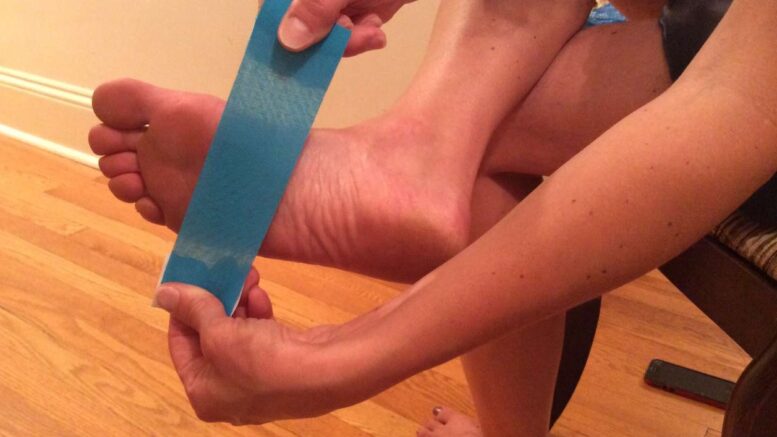Plantar fasciitis is one of the most common causes of heel pain, affecting millions of people worldwide. This condition is caused by inflammation of the tissue band that runs along the bottom of the foot, called the plantar fascia.
While there are various treatment options available, KT (Kinesio Taping) techniques have been gaining popularity in recent years as a safe and effective management strategy for plantar fasciitis. In this comprehensive overview, we will explore and discuss various KT taping techniques for plantar fasciitis, how they work, and their benefits.
The primary goal of KT tape is to reduce pain and inflammation, improve blood circulation and support the affected area, allowing it to heal faster. KT taping starts with a thorough assessment of the injury to determine the best possible taping method to use.
With a variety of different techniques available, it’s important to understand the specific purpose of each technique and how to correctly apply the tape to achieve optimal results.
Overview of the KT Tape Technique
KT Tape is a type of elastic sports tape that has been used to treat a wide range of injuries, including plantar fasciitis. It is designed to provide support and stability to the affected area while still allowing for a full range of motion.
The tape is made from a high-quality cotton blend and is designed to be sweat-resistant and durable. The plantar fasciitis kt taping technique involves applying the tape directly to the affected area in a specific pattern, which can help to reduce pain, inflammation, and swelling. When applied correctly, KT Tape can also help to improve circulation and promote healing.
In the following sections, we will provide a detailed overview of the KT Tape technique for plantar fasciitis, including information on how to apply the tape correctly, how long it should be worn, and possible side effects.
Benefits of KT Tape for Plantar Fasciitis
KT taping, also known as Kinesio taping, has gained popularity in recent years as a non-invasive treatment option for various musculoskeletal conditions, including plantar fasciitis. Plantar fasciitis is a common foot condition that occurs as a result of inflammation of the plantar fascia, a thick band of tissue running along the bottom of the foot.
KT tape is a thin, elastic cotton strip with an acrylic adhesive that is applied to the skin over the affected area. The tape works by providing mechanical support and reducing stress on the plantar fascia, which can alleviate pain and promote healing.
Tips for Proper Application of KT Tape
KT Tape has become increasingly popular as a method to manage plantar fasciitis symptoms. However, proper application is key to ensuring it is effective. Here are three tips for the proper application of KT Tape:
- Prepare the skin: Before applying KT Tape, ensure that the skin on the affected area is clean and dry. Avoid using any lotions or oils that may interfere with the tape’s adhesive.
- Proper tension: The amount of tension applied to the tape is crucial for effective results. Too little tension can result in ineffective support, while too much can cause discomfort and even worsen symptoms. Start with a mild tension and adjust accordingly.
- Proper placement: Ensure that KT Tape is properly placed according to the area of pain and discomfort. For plantar fasciitis, it is important to apply the tape underneath the arch of the foot and around the heel. Proper placement will provide the necessary support and relief.
With these three tips, proper application of KT Tape can be achieved, resulting in effective management of plantar fasciitis symptoms.
Recommended Taping Patterns
The use of Kinesiology Tape (KT) is an effective technique for the treatment of plantar fasciitis. With proper application of KT, inflammation and pain in the affected area can be reduced, while also providing support to the plantar fascia.
To ensure maximum benefits, it is important to note that the taping pattern used should be appropriate for the specific symptoms present. Here, we present 4 recommended taping patterns that can be used in the treatment of plantar fasciitis – classic X-pattern, fan pattern, heel lock, and toe extensor pattern.

Each technique has its own benefits and is appropriate for different levels of severity. It is recommended to consult with a healthcare professional for precise guidance on which taping pattern is best suited for individual patients.
Guidelines for Care and Maintenance
In order to ensure the longevity and effectiveness of KT Taping techniques for Plantar Fasciitis, proper care and maintenance of the tape is crucial. The following guidelines should be followed to ensure that the tape remains secure and effective between applications:
- Clean and dry the affected area thoroughly before applying the tape. Skin oils, lotions, and sweat can compromise the adhesive quality of the tape.
- Avoid touching the adhesive side of the tape as much as possible. Oils and dirt from your fingers can affect the tackiness of the tape.
- Do not apply the tape over any open wounds or abrasions.
- Avoid exposing the tape to water or moisture as much as possible. If the tape does get wet, gently pat it dry with a towel and avoid rubbing or scrubbing the area.
- Change the tape at least every 3-5 days, or sooner if it becomes loose or uncomfortable. Proper care and maintenance of the tape will ensure that it stays securely in place, providing maximum benefit to the affected area.
Conclusively, KT taping techniques are an effective treatment option for dealing with plantar fasciitis. The benefits of KT taping are numerous, including pain relief, improved arch support, and reduced inflammation. With proper application, KT taping can also enhance proprioception, and prevent further injury. If you suffer from plantar fasciitis, consider discussing these taping techniques with your physical therapist or healthcare provider to see if it is a good fit for your condition.
